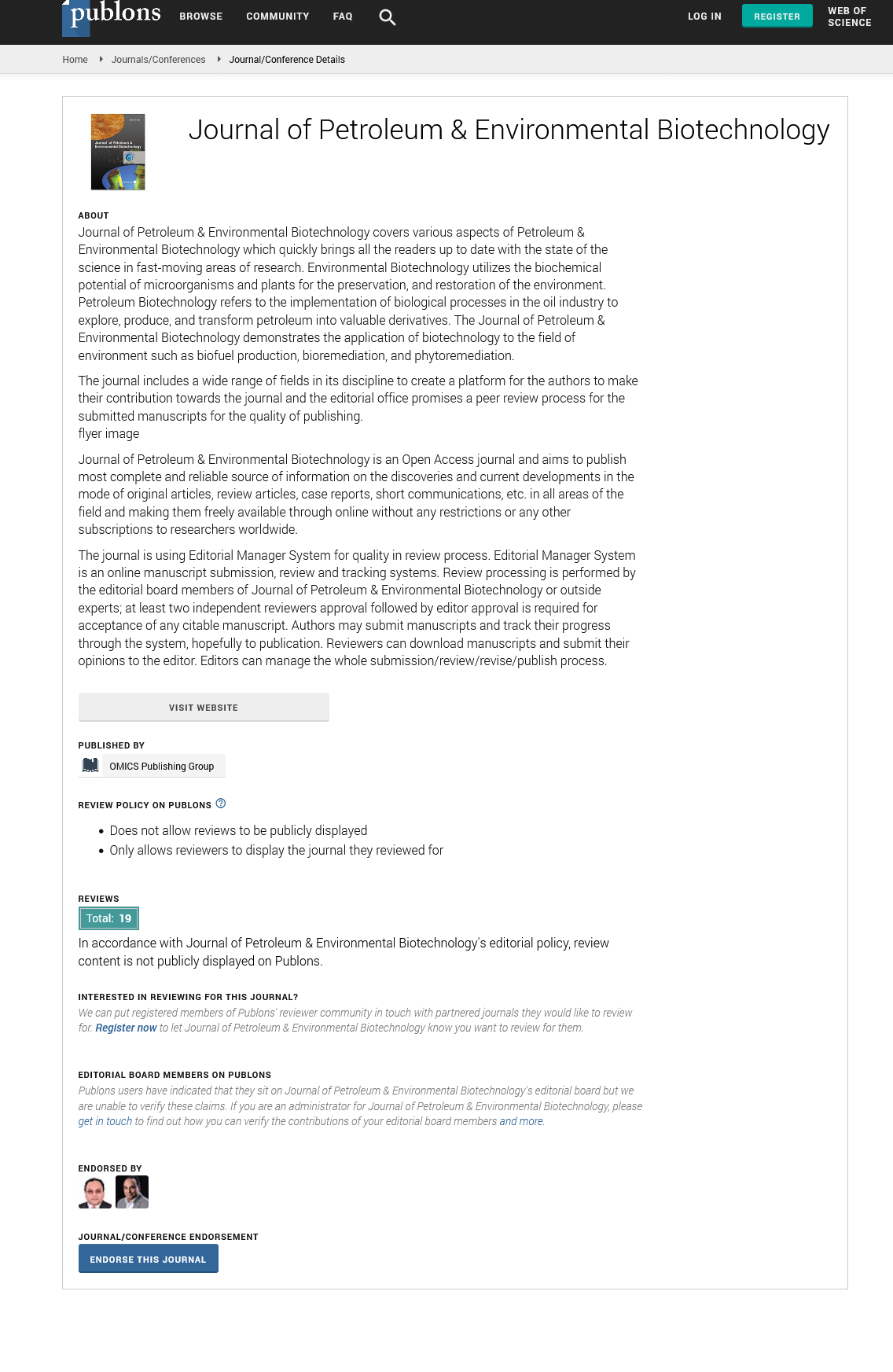Indexed In
- Open J Gate
- Genamics JournalSeek
- JournalTOCs
- China National Knowledge Infrastructure (CNKI)
- Electronic Journals Library
- RefSeek
- Hamdard University
- EBSCO A-Z
- OCLC- WorldCat
- SWB online catalog
- Virtual Library of Biology (vifabio)
- Publons
- MIAR
- Euro Pub
- Google Scholar
Useful Links
Share This Page
Journal Flyer

Open Access Journals
- Agri and Aquaculture
- Biochemistry
- Bioinformatics & Systems Biology
- Business & Management
- Chemistry
- Clinical Sciences
- Engineering
- Food & Nutrition
- General Science
- Genetics & Molecular Biology
- Immunology & Microbiology
- Medical Sciences
- Neuroscience & Psychology
- Nursing & Health Care
- Pharmaceutical Sciences
Commentary - (2024) Volume 15, Issue 4
The Evolution of Biotechnology in Revolutionizing Environmental Management and Bioremediation
Honfeg Dozies*Received: 25-Nov-2024, Manuscript No. JPEB-24-27956; Editor assigned: 29-Nov-2024, Pre QC No. JPEB-24-27956 (PQ); Reviewed: 13-Dec-2024, QC No. JPEB-24-27956; Revised: 20-Dec-2024, Manuscript No. JPEB-24-27956 (R); Published: 27-Dec-2024, DOI: 10.35248/2157-7463.24.15.587
Description
Environmental biotechnology is a field of science that uses microorganisms, plants and enzymes to address environmental issues, such as pollution, waste management and the conservation of natural resources. This discipline utilizes the power of biological processes to promote environmental sustainability and address global challenges, ranging from air and water pollution to climate change and waste disposal. The application of biotechnology has revolutionized the way we tackle environmental problems, providing innovative, efficient and sustainable solutions. This manuscript explores the various facets of environmental biotechnology, highlighting its applications, techniques and future prospects.
Environmental biotechnology involves the use of living organisms and their derivatives to remediate environmental contaminants enhance the recycling of waste and restore the ecological balance. It encompasses a broad range of applications, including bioremediation, waste treatment and bioenergy production. The primary goal of environmental biotechnology is to develop sustainable technologies that can address the critical environmental issues associated with industrialization, urbanization and population growth.
The field has gained significant attention in recent decades due to the increasing awareness of the environmental degradation caused by human activities. With the growing population and industrial activities, the world faces mounting challenges such as air and water pollution, climate change and the depletion of natural resources. Environmental biotechnology offers a promising alternative to conventional environmental management methods by providing solutions that are cost-effective, energy-efficient and environmentally friendly. One of the most important applications of environmental biotechnology is bioremediation, the process of using microorganisms, plants, or enzymes to degrade or detoxify pollutants. Bioremediation can be applied to a wide range of environmental contaminants, including heavy metals, organic compounds and petroleum products. Microorganisms, such as bacteria, fungi and algae, possess the natural ability to break down harmful substances into less toxic or non-toxic forms through biochemical reactions.
The bioremediation process can occur naturally or be enhanced through engineered interventions. In situ bioremediation refers to the treatment of contaminants directly at the polluted site, while ex situ bioremediation involves the removal of contaminated materials, such as soil or water, to be treated in a controlled environment. Bioremediation has been successfully used to clean up oil spills, where bacteria break down the hydrocarbons in the oil into carbon dioxide and water. In addition to its role in cleaning up pollutants, bioremediation offers several advantages over traditional methods, such as chemical treatment or physical removal. It is a sustainable and low-cost solution that minimizes the need for hazardous chemicals and reduces the environmental impact of the cleanup process. Furthermore, bioremediation can be applied to a variety of contaminants and can be tailored to the specific characteristics of the pollution.
Another significant application of environmental biotechnology is wastewater treatment, which involves the use of biological processes to treat and purify water contaminated by organic waste, chemicals and pathogens. Traditional wastewater treatment methods, such as chemical coagulation and filtration, can be expensive and energy-intensive. Biological treatment processes are more sustainable and cost-effective. Activated sludge systems, one of the most widely used biological treatment methods, rely on the activity of microorganisms to break down organic matter in wastewater. The microorganisms consume the organic pollutants, converting them into biomass and carbon dioxide. The treated water can then be discharged into the environment or further processed for reuse. Other biological treatment methods, such as constructed wetlands and biofilm reactors, also utilize natural processes to remove contaminants from wastewater. The key advantage of biological wastewater treatment is its ability to degrade a wide range of organic pollutants, including nitrogen and phosphorus compounds, which are common contributors to water eutrophication. Biological treatment also offers the potential for resource recovery, such as the production of biogas from organic waste, which can be used as a renewable energy source.
Bioenergy is another critical area within environmental biotechnology, involving the conversion of organic waste into renewable energy sources, such as biogas, bioethanol and biodiesel. The production of bioenergy from waste materials not only helps in reducing waste but also provides an alternative to fossil fuels, which are a major source of environmental pollution and greenhouse gas emissions. The conversion of organic waste into bioenergy can be achieved through various biotechnological processes, including anaerobic digestion, fermentation and enzymatic hydrolysis. In anaerobic digestion, microorganisms break down organic matter in the absence of oxygen, producing biogas, which primarily consists of methane. This biogas can be used for electricity generation, heating, or as a vehicle fuel. Fermentation processes, on the other hand, convert sugars present in biomass into bioethanol, which can be used as a substitute for gasoline.
Citation: Dozies H (2024). The Evolution of Biotechnology in Revolutionizing Environmental Management and Bioremediation. J Pet Environ Biotechnol. 15:587.
Copyright: © 2024 Dozies H. This is an open-access article distributed under the terms of the Creative Commons Attribution License, which permits unrestricted use, distribution, and reproduction in any medium, provided the original author and source are credited.

